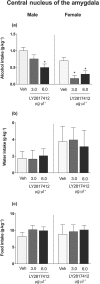NOP receptor antagonism reduces alcohol drinking in male and female rats through mechanisms involving the central amygdala and ventral tegmental area
- PMID: 31713848
- PMCID: PMC7060370
- DOI: 10.1111/bph.14915
NOP receptor antagonism reduces alcohol drinking in male and female rats through mechanisms involving the central amygdala and ventral tegmental area
Abstract
Background and purpose: Nociceptin/orphanin FQ (N/OFQ) peptide and its cognate receptor (NOP) are widely expressed in mesolimbic brain regions where they play an important role in modulating reward and motivation. Early evidence suggested that NOP receptor activation attenuates the rewarding effects of drugs of abuse, including alcohol. However, emerging data indicate that NOP receptor blockade also effectively attenuates alcohol drinking and relapse. To advance our understanding of the role of the N/OFQ-NOP receptor system in alcohol abuse, we examined the effect of NOP receptor blockade on voluntary alcohol drinking at the neurocircuitry level.
Experimental approach: Using male and female genetically selected alcohol-preferring Marchigian Sardinian (msP) rats, we initially evaluated the effects of the selective NOP receptor antagonist LY2817412 (3, 10, and 30 mg·kg-1 , p.o.) on alcohol consumption in a two-bottle free-choice paradigm. We then microinjected LY2817412 (3 and 6 μg·μl-1 per rat) in the central nucleus of the amygdala (CeA), ventral tegmental area (VTA), and nucleus accumbens (NAc).
Key results: Peripheral LY2817412 administration dose-dependently and selectively reduced voluntary alcohol intake in male and female msP rats. Central injections of LY2817412 markedly attenuated voluntary alcohol intake in both sexes following administration in the CeA and VTA but not in the NAc.
Conclusion and implications: The present results revealed that the CeA and VTA are neuroanatomical substrates that mediate the effects of NOP receptor antagonism on alcohol consumption. Overall, our findings support the potential of NOP receptor antagonism as a treatment strategy to attenuate alcohol use and addiction.
© 2019 The British Pharmacological Society.
Conflict of interest statement
The authors have no conflict of interest with the subject matter or materials discussed in the manuscript.
Figures




References
-
- Aujla, H. , Cannarsa, R. , Romualdi, P. , Ciccocioppo, R. , Martin‐Fardon, R. , & Weiss, F. (2013). Modification of anxiety‐like behaviors by nociceptin/orphanin FQ (N/OFQ) and time‐dependent changes in N/OFQ‐NOP gene expression following ethanol withdrawal. Addiction Biology, 18, 467–479. 10.1111/j.1369-1600.2012.00466.x - DOI - PMC - PubMed
-
- Aziz, A. M. , Brothers, S. , Sartor, G. , Holm, L. , Heilig, M. , Wahlestedt, C. , & Thorsell, A. (2016). The nociceptin/orphanin FQ receptor agonist SR‐8993 as a candidate therapeutic for alcohol use disorders: Validation in rat models. Psychopharmacology, 233, 3553–3563. 10.1007/s00213-016-4385-8 - DOI - PMC - PubMed
-
- Becker, H. C. , & Lopez, M. F. (2004). Increased ethanol drinking after repeated chronic ethanol exposure and withdrawal experience in C57BL/6 mice. Alcoholism, Clinical and Experimental Research, 28, 1829–1838. - PubMed
-
- Bunzow, J. R. , Saez, C. , Mortrud, M. , Bouvier, C. , Williams, J. T. , Low, M. , & Grandy, D. K. (1994). Molecular cloning and tissue distribution of a putative member of the rat opioid receptor gene family that is not a μ, δ or κ opioid receptor type. FEBS Letters, 347, 284–288. 10.1016/0014-5793(94)00561-3 - DOI - PubMed
Publication types
MeSH terms
Substances
Grants and funding
LinkOut - more resources
Full Text Sources
Medical
Research Materials

